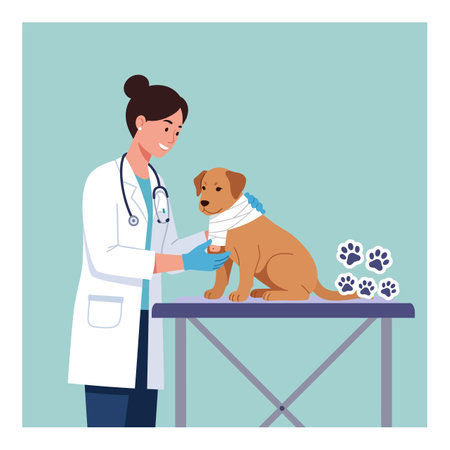Understanding Chronic GI Issues in Pets
If you’re a pet parent, you know how important it is to keep an eye on your furry friend’s health, especially when it comes to their tummy troubles. Chronic gastrointestinal (GI) issues in cats and dogs are more common than you might think, and they can have a big impact on your pet’s overall well-being. These long-term digestive problems aren’t just occasional upsets—they stick around and can cause ongoing discomfort for your pet. Common signs of chronic GI issues include frequent vomiting or diarrhea, changes in appetite, weight loss, excessive gas, bloating, and even chronic licking at the belly area. Sometimes, you might notice your dog or cat straining during potty breaks or having accidents in the house or outside the litter box. If these symptoms last for weeks or keep coming back, it’s time to take notice. By understanding what to look out for, you can catch potential problems early and help your pet get the care they need for a happy, healthy life on the homestead.
IBS vs. IBD: What’s the Difference?
If your furry friend is struggling with tummy troubles, you might hear your vet mention “IBS” or “IBD.” These two acronyms sound similar, but they aren’t quite the same thing! Both conditions involve long-term gastrointestinal (GI) issues, but understanding the difference can help you better support your pet’s health and happiness.
The Basics: IBS and IBD Explained
Irritable Bowel Syndrome (IBS) in pets is more about the gut acting up without obvious physical changes to the intestines. Think of it like a sensitive stomach—your dog or cat may have diarrhea, constipation, or gurgly tummies when they’re stressed or eat something unusual, but their GI tract looks normal under the microscope.
Inflammatory Bowel Disease (IBD) is a different beast. Here, there’s actual inflammation in your pet’s intestinal lining. This inflammation makes it hard for them to digest food and absorb nutrients, leading to chronic vomiting, diarrhea, weight loss, and sometimes even a scruffy coat or lackluster energy.
Key Differences at a Glance
| Feature | IBS | IBD |
|---|---|---|
| Main Cause | Functional issue (stress, diet changes) | Physical inflammation of GI tract |
| Symptoms | Mild-moderate digestive upset; often linked to stress | Chronic vomiting, diarrhea, weight loss; ongoing symptoms |
| Diagnosis | By ruling out other problems; no visible tissue damage | Confirmed by biopsy; visible inflammation on tests |
| Treatment Focus | Diet change, stress reduction | Medication, special diets, sometimes lifelong management |
A Friendly Example from the Farmhouse
Imagine your dog gets an upset stomach every time there’s a thunderstorm—that’s more like IBS. But if your cat keeps losing weight and has frequent diarrhea no matter what you feed her, that’s closer to IBD. While both need attention, IBD usually means a more serious and ongoing commitment to care.
![]()
3. Other Persistent Tummy Troubles
While IBS and IBD are some of the most talked-about chronic GI issues in our furry friends, there’s a whole field of other tummy troubles that can make life uncomfortable for pets—and their people! Let’s take a closer look at a few more sneaky culprits behind those persistent digestive upsets, from food sensitivities to allergies and even chronic pancreatitis.
Food Sensitivities: The Hidden Aggravators
Just like us, pets can develop sensitivities to certain foods over time. These aren’t always classic allergies (which trigger immune reactions), but they can still cause ongoing issues like loose stools, gassiness, or skin irritation. Common offenders include chicken, beef, grains, or even specific additives found in commercial pet foods. Sometimes it takes a little detective work and an elimination diet—usually under your vet’s guidance—to sniff out what’s bothering your fur baby’s belly.
Allergies: More Than Just Sneezing
Food allergies in pets can show up as chronic GI problems, too. While itchy skin is often the first sign that comes to mind, many dogs and cats with food allergies experience vomiting, diarrhea, or excessive licking around their hindquarters. Environmental allergens (like pollen or dust mites) can also play a role in irritating the gut, especially if your pet already has sensitive digestion.
Chronic Pancreatitis: When the Pancreas Gets Grumpy
The pancreas is a small but mighty organ that helps digest food and regulate blood sugar. When it becomes inflamed over time—a condition called chronic pancreatitis—pets may have bouts of vomiting, appetite loss, and abdominal pain that come and go. This condition is most common in middle-aged or older dogs (especially schnauzers and other breeds prone to high blood fats), but cats can suffer from it too. Managing chronic pancreatitis usually means sticking to a low-fat diet and sometimes lifelong medication.
The Role of Stress and Lifestyle
It’s worth noting that stress can be a big trigger for all these issues—whether it’s moving house, changes in routine, or new family members (two- or four-legged). Creating a calm home environment and keeping mealtimes predictable can help soothe sensitive tummies.
When to Seek Veterinary Help
If your pet is having ongoing digestive trouble—think frequent diarrhea, vomiting, weight loss, or just not acting like themselves—it’s always best to reach out to your veterinarian. Chronic GI conditions are best managed with a tailored approach that may include special diets, medications, probiotics, and plenty of patience (and snuggles!). Remember: you know your pet best, so trust your instincts if something seems off.
4. Diagnosing GI Conditions: What to Expect at the Vet
When your furry companion starts showing signs of long-term gastrointestinal (GI) issues, a trip to your local vet is the first step toward getting them back on track. Understanding what to expect during this process can help ease your worries and make sure your pet gets the best possible care. Here’s a breakdown of the usual steps and tests involved in diagnosing GI conditions like IBS, IBD, and other chronic digestive problems in pets.
Initial Examination
Your vet will start by asking about your pet’s history—think of it as a little story time about their tummy troubles. You’ll want to mention any changes in appetite, stool consistency, vomiting, weight loss, or energy levels. After this chat, the vet will perform a physical examination, checking for signs of dehydration, abdominal discomfort, and overall body condition.
Common Diagnostic Tests
If your vet suspects a chronic GI issue, they may recommend some diagnostic tests to get a clearer picture. Here’s a quick overview of what might be suggested:
| Test/Procedure | What It Checks For | Why It Matters |
|---|---|---|
| Fecal Exam | Parasites or bacteria | Rules out infections that mimic GI disorders |
| Bloodwork (CBC/Chemistry Panel) | Organ function & inflammation | Assesses overall health and finds underlying issues |
| X-rays or Ultrasound | Physical abnormalities in GI tract | Identifies blockages or tumors |
| Endoscopy/Biopsy | Tissue samples from GI tract | Diagnoses IBD, cancer, or severe inflammation |
The Process: Step by Step
- Your pet may need to fast before certain tests (your vet will let you know).
- Mild sedation might be required for imaging or endoscopic procedures—don’t worry, vets are pros at keeping pets comfy!
- You might get results within hours for some tests (like bloodwork), while others (like biopsies) can take several days.
Tips for Pet Parents
- Bring a fresh stool sample if possible—it saves time and gives more accurate results.
- Write down all symptoms and when they started; details matter!
- If you have multiple pets with similar symptoms, mention it—sometimes environmental factors play a role.
Navigating the diagnosis process with your vet is a partnership. By knowing what to expect and preparing ahead of time, you’re taking big strides toward helping your pet feel their best. Remember, patience is key—just like growing a healthy garden or introducing a new puppy into the family, good things take time!
5. Treatment and Management Options for Chronic GI Problems
Managing chronic gastrointestinal issues like IBS and IBD in our furry companions requires a thoughtful, multi-faceted approach. Every pet is unique, so finding the right combination of treatments may take some time and patience—but with consistent care, many pets can enjoy a happy, comfortable life.
Medication: When Your Vet Recommends It
For pets with more severe or persistent symptoms, your veterinarian might prescribe medications such as anti-inflammatories, immune suppressants, or even antibiotics to control flare-ups. These medicines are often used to reduce inflammation in the gut and help manage pain or discomfort. Always follow your vet’s instructions closely and keep an eye out for any side effects.
Dietary Changes: The Power of Food
Many chronic GI issues can be eased—or sometimes resolved—by making changes to your pet’s diet. Some pups and kitties benefit from limited ingredient diets, novel protein sources, or hypoallergenic formulas. Fiber-rich foods can help regulate digestion, while avoiding common triggers like dairy or certain grains may prevent flare-ups. Remember, sudden food changes can upset sensitive stomachs, so make any transitions slowly over 7–10 days.
Supplements That Support Gut Health
Probiotics and prebiotics are popular choices for maintaining a healthy balance of gut bacteria. Omega-3 fatty acids may also help reduce inflammation in pets with IBD. Ask your vet which supplements are best suited for your pet’s specific condition—sometimes a little boost makes all the difference!
The Importance of Routine and Stress Reduction
Our pets thrive on routine—especially those with GI sensitivities. Feeding them at the same times each day, sticking to regular walk or play schedules, and providing a calm environment can help minimize stress-related tummy troubles. Simple comforts like cozy beds and safe spaces also make a big difference when managing long-term health conditions.
Working Together With Your Vet
A strong partnership with your veterinarian is key to successful management of chronic GI problems. Regular check-ins allow you to monitor progress, adjust medications or diet as needed, and catch potential complications early. With patience and proactive care, you’ll give your beloved four-legged friend the best chance at a healthy, happy life—even if their tummy needs a little extra TLC!
6. Home Life with a Pet Who Has GI Issues
Country Living: Making Room for Sensitive Tummies
Out here in the countryside, where chickens roam and the morning fog hugs the fields, life moves at a gentler pace—perfect for pets who need extra TLC for their tummies. When you share your home with a cat or dog managing IBS or IBD, every day is about creating comfort and calm. Our barn cats, Molly and Jasper, both have sensitive stomachs, so we’ve learned a few tricks to keep them happy. For starters, we stick to simple, consistent routines; feeding times are like clockwork and we avoid any sudden menu changes. Their food bowls are always clean, tucked away from the hustle of our busy farmhouse kitchen.
Tips for a Happy, Stress-Free Home
- Routine is Everything: Pets with GI issues thrive on predictability. Keep mealtimes and walks at the same time each day. Even our border collie, Max, knows when it’s time for his special breakfast!
- Create Quiet Spaces: Designate a cozy corner or a sunlit window seat where your pet can rest undisturbed. Our old porch swing doubles as a napping spot for our dogs when their bellies are upset.
- Watch Treats and Table Scraps: It’s tempting to share your picnic under the oaks, but resist giving your pet unfamiliar foods. We stick to homemade treats that are gentle on digestion—pumpkin biscuits for the pups and boiled chicken for the kitties.
- Mental Health Matters: Stress can flare up GI symptoms. We use gentle playtime, soothing music (the kind you’d hear drifting across farm fields), and lots of cuddles to help everyone relax.
- Keep Nature Close: Fresh air and sunshine work wonders! A slow stroll through the pasture or lazy afternoon naps by the garden help settle anxious tummies and spirits alike.
Our Story: Finding Joy Amid Tummy Troubles
Caring for pets with chronic digestive issues isn’t always easy—but it’s deeply rewarding. Each morning when Jasper purrs on my lap or Max brings me his ball with that wagging tail, I’m reminded that even with all their dietary quirks and vet visits, they fill our home with joy. The secret? Patience, understanding, and a touch of that country spirit. By embracing their needs and making small changes around the house, you’ll create a sanctuary where sensitive stomachs—and loving hearts—can truly flourish.


